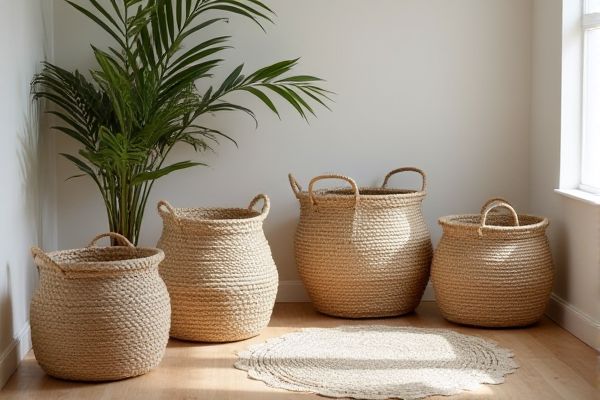
Choosing between baskets and bins for storage depends on your organizational needs and aesthetic preferences, as baskets offer breathability and style while bins provide stackable, space-saving functionality. Explore the rest of the article to discover which option best suits your storage solutions and enhances your space.
Table of Comparison
| Feature | Baskets | Bins |
|---|---|---|
| Material | Wicker, plastic, metal, fabric | Plastic, metal |
| Design | Open weave, breathable | Solid, enclosed |
| Airflow | High, prevents moisture buildup | Low, may trap moisture |
| Visibility | Usually visible contents | Opaque or clear options available |
| Stackability | Limited, depends on shape | Designed for stacking |
| Weight | Generally lightweight | Varies; often heavier than baskets |
| Ideal uses | Clothing, toys, laundry | Tools, hardware, large bulk items |
| Durability | Moderate, less impact-resistant | High, impact-resistant |
| Cost | Generally affordable | Varies, often costlier |
Understanding Baskets and Bins: Key Differences
Baskets and bins differ primarily in material, design, and intended use; baskets are often woven and provide breathable storage, ideal for items needing ventilation, while bins are usually made of solid plastic or metal, offering stackable, enclosed storage perfect for protecting items from dust and moisture. Understanding these distinctions helps you choose the best storage solution based on your space, organization needs, and the type of items you want to store. Baskets enhance aesthetic appeal and accessibility, whereas bins maximize capacity and durability for long-term storage.
Material Matters: What Baskets and Bins Are Made Of
Baskets are typically crafted from natural materials such as wicker, rattan, or seagrass, offering a breathable and aesthetically pleasing storage option that complements rustic or bohemian decor. In contrast, bins are commonly made from durable plastics, metal, or fabric, providing robust, stackable, and moisture-resistant solutions ideal for maximizing space in garages, closets, or basements. Your choice between baskets and bins should consider the material's durability, ventilation, and style to suit your specific storage needs.
Aesthetic Appeal: Style Comparison
Baskets offer a natural, rustic aesthetic with woven textures that complement bohemian and farmhouse decor, while bins provide a sleek, modern look with smooth surfaces and uniform shapes ideal for contemporary or minimalist spaces. Wicker and rattan baskets add warmth and organic charm, whereas plastic or metal bins deliver a clean, streamlined appearance emphasizing functionality. Choosing between baskets and bins depends on whether the focus is on decorative appeal or practical, space-saving design.
Space Efficiency: Which Saves More Room?
Baskets and bins both offer practical storage solutions, but bins typically save more space due to their stackable design and uniform shape, maximizing vertical storage in closets or shelves. Baskets, while aesthetically pleasing and easier to access, often have irregular shapes that can lead to wasted space when arranged together. Choosing bins can enhance your storage efficiency by optimizing every inch of available space, especially in tight or small areas.
Organization and Accessibility
Baskets offer lightweight, breathable storage ideal for organizing smaller or irregularly shaped items, enhancing visual accessibility and easy retrieval. Bins provide stackable, durable solutions suited for bulkier belongings, maximizing space efficiency while keeping items protected but slightly less visible. Your choice between baskets and bins depends on your need for quick access versus compact, secure storage.
Versatility: Where Baskets or Bins Work Best
Baskets excel in versatility for open storage needs, offering easy access and aesthetic appeal in living rooms, closets, or bathrooms where visibility and ventilation matter. Bins provide superior containment for stacking and organizing small items, making them ideal for garages, pantries, or warehouses where durability and secure closure are priorities. Choosing the right option depends on your storage goals, balancing convenience with protection for your belongings.
Durability and Longevity
Baskets made from natural fibers or plastic offer moderate durability but may degrade over time with heavy use or exposure to moisture. Bins, especially those constructed from hard plastic or metal, provide superior longevity and resistance to wear, making them ideal for long-term storage solutions. Choosing the right option depends on your storage needs, balancing aesthetic appeal with the durability required for your belongings.
Maintenance and Cleaning Tips
Baskets are typically easier to clean as they often have open weaves that allow dust and debris to be easily shaken out or wiped down with a damp cloth. Bins, especially those made of plastic or metal, can be thoroughly washed with soap and water, making them more suitable for storing items prone to spills or dirt. Regular cleaning of both baskets and bins helps prevent the buildup of dust, mold, and odors, extending their usability and maintaining a sanitary storage environment.
Cost Comparison: Budget Considerations
Baskets generally offer a lower upfront cost compared to bins, making them a budget-friendly option for basic storage needs. Bins, often made from durable materials like plastic or metal, may have a higher initial price but provide long-term value through enhanced protection and longevity. Considering factors like intended use, durability, and frequency of replacement helps in making a cost-effective choice between baskets and bins.
Eco-Friendly Storage Solutions: Baskets vs Bins
Eco-friendly storage solutions often favor baskets made from natural materials like wicker, seagrass, or cotton, which are biodegradable and sustainable. Bins, typically constructed from plastic, may offer durability and stackability but pose environmental concerns due to non-biodegradability and production emissions. Choosing your storage option with sustainability in mind supports reducing your carbon footprint and promotes recycling or composting practices.
 homyna.com
homyna.com